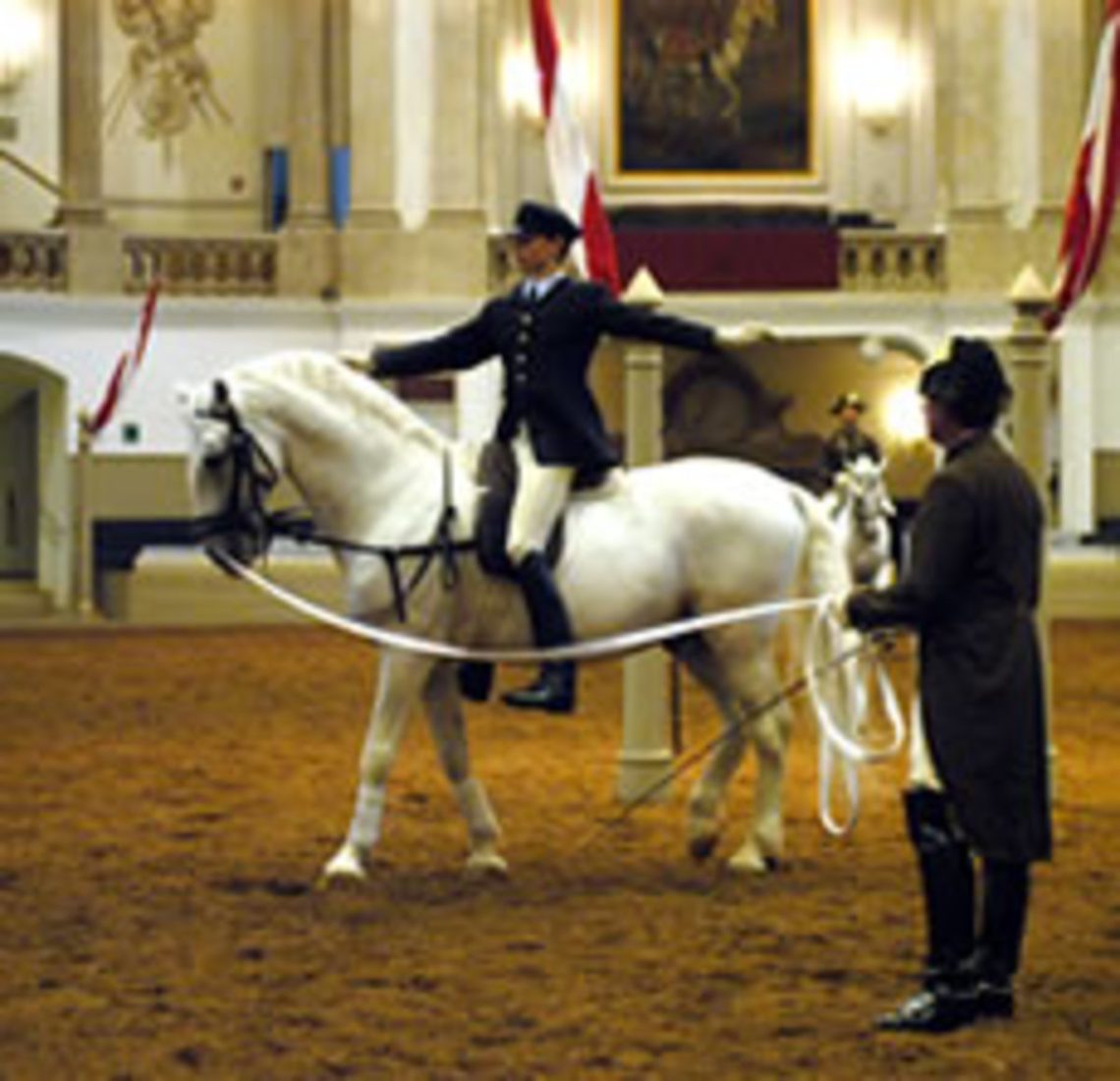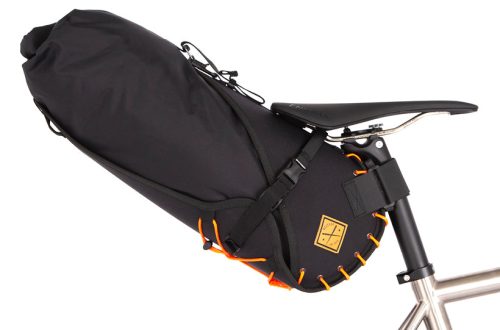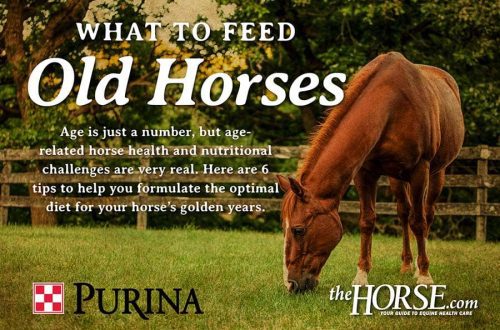
Report: lessons from the senior rider of the Spanish Riding School
Creating harmony and expressiveness.
It is not every day that riders have the opportunity to learn firsthand about the teaching methods passed down from generation to generation by the masters of the Spanish Riding School. My reportage was the result of the presence of Andreas Hausberger, the head rider of the School, at the lessons. Rider training under his direction was organized at Pasmore Stables in Whitehall, Virginia.
Andreas performs at a show in Rotterdam, the Netherlands.
During each 45-minute one-to-one training session, Andreas followed a consistent lesson structure to draw riders’ attention to the details that boosted their self-confidence.
The lessons were structured as follows:
- The riders independently warmed up the horses outside the arena.
- After being invited to the arena, they demonstrated the posting and training trot, moved in circles, serpentines and worked along the wall, while Andreas focused on the quality of the trot and the rider’s position. As soon as these “components” satisfied him …
- riders performed changes of direction at a trot through 20-meter circles. When their horses became balanced and alert…
- the riders began to gallop. Once again Andreas was looking for quality in both gaits and riders.
- Then the riders performed changes at a gallop. Andreas asked them to demonstrate correct half halts and the ability to maintain the right pace.
- During a short break, the riders were asked to let the horses stretch out, “to ask the snaffle down and forward.”
- The break was followed by work in a collected trot in training position or in a collected canter, which was focused on developing the quality of lateral movements, the development of a clearer collection, stable expression, a clearer rhythm and greater harmony.
- At each lesson, the horses were worked by hand. On the first day – after work under the saddle, on the second and third – before. The goal was to improve connectivity and encourage horses to carry themselves.
As part of the proposed training structure, Andreas helped riders overcome a variety of difficulties, from pinching the horse’s body with the knee to maintaining their own body in the necessary tone and elasticity in order to correct the horse’s inward bend during the shoulder-in exercise.
Proper posture while riding
In the early stages of training, Andreas corrected landing errorsboth significant and not so significant, including:
1. Grabbing the knees and hips of the horse’s body
One of the riders, who was at a relatively low level of training, did not understand that she was holding onto the horse with her knees and hips and this prevented the horse from moving smoothly and maintaining a clear rhythm. To help her loosen her leg, Andreas forced her to tear her knees off the saddle (the legs remained at the sides of the horse). When the rider returned to her old habit, he again reminded her to loosen her knee. The difference in her horse’s movements became easy to see when they started working on the transitions to the trot on the 20-meter circle: if the rider pinched the horse with her knees, there were problems maintaining the medium trot, and the collected trot became jittery, the horse looked pinched. When the rider worked, holding the legs as if “they were resting on the sides of the horse,” the horse’s movements became more fluid and elegant.
2. Holding the seat deep in the saddle
She was also a rider who switched from show jumping to dressage a few years ago. She tried her best to sit deep in the saddle. As a result, her horse regularly “pulled” her out of the correct position. The solution was found and carried out in two stages:
Step 1. The rider focused on getting the horse to yield at the neck. To do this, she held the upper arm against the body, and this was carried out due to the work of the shoulders, and not the muscles of the hands. At the same time, she encouraged her horse to continue doing the same work with the same activity throughout the lesson. As the balance between contact and energy improved, the horse began to give way in the neck. Andreas then asked the rider to raise the arch of the neck a little higher, which could be done by sitting deeper. into the saddle. The result was a further softening in the neck of the horse, which no longer rested against the hands of the rider.
Step 2. Once the horse was lighter in her hands, the rider dropped the stirrups and focused on keeping the horse’s neck in the set position for the 20m circle. When she had to keep the horse’s neck from going too low, her seat became deeper and deeper. By the end of the lesson, without stirrups, she was performing multiple canter-training trot and medium trot-collected trot transitions. On the second day, she also worked without stirrups, but from the very beginning of the lesson, and the horse did not pull her. The landing of the rider has become more durable and reliable. They then moved on to shoulder-in, half-passes, and riding to a higher degree of collection.
3. Keeping the core supple, the wrists soft and the shoulders down
An experienced rider with a high level of training tried very hard to maintain the elasticity of his body (without small bouncing back and forth), keep the wrists soft, and keep his shoulders down. Andreas paid attention to the relaxation of the wrists in every transition and in every movement, pointing out the tension when it appeared. At the same time, the tendency to raise the shoulders decreased. This made the rider realize how one small mistake in the seat can lead to the development of a big one. As the shoulders lowered, the elasticity and stability of the rider’s body improved. But to further improve it, Andreas increased the frequency of transitions and diversified them – ascending and descending transitions within and between gaits, on serpentines and circles of different sizes, on lateral movements. He kept a close eye on the execution and always corrected the rider instantly when his wrists froze again, starting a chain reaction of mistakes.
Lateral movements and collection
After working on improving the fit, Andreas turned his attention to collection. He again followed a clear pattern in his work, but complicated it by focusing on the right pace and the horse’s ability to carry himself.
One of the challenges that came up often was to prevent the horse from bending the horse’s head inward too much when doing the shoulder-in.
Andreas asked the riders to ride the collected trot in a circle and shoulder-in. While they were working on it, he recalled that the goal was to have the horse’s shoulder inside, not the horse’s head. To encourage riders to pay attention to the inward bend of the horse’s head, he asked them to use a counter-position while riding while keeping their shoulder in. With this simple adjustment, horses that tended to flex their head inward excessively improved their head and neck position. They also showed a clearer and less rushed execution of the shoulder in, with an emphasis on the “shoulder in” (and later on the half). Andreas explained that riding with a counter-setting encourages the rider to “pay more attention to the outside rein”. In this correct position, the riders were able to shoulder-in all over the arena as well as the center line. He then asked the riders to change direction, performing 10-meter circles from the center line and returning to it over the shoulder inward to the left or right.
Some horses have experienced errors during the exercise, but the reason for their appearance was the immobility and tightness of the riders in the hips, which limited the ability of the horse to work well. Andreas came up with a simple solution: riders moved their seats to the middle of the saddle and their seat improved.
After the riders had worked on this exercise, Andreas incorporated it into a peculiar riding pattern (e.g. shoulder-forward circle – shoulder-in long wall – 10-meter circle at B or E shoulder-in in two gaits: canter and trot).
Andreas then asked the riders to include the half-ass in their work, emphasizing two main ideas of the half-ass:
1. Should always be shoulder-in before taking.
2. Move slowly. If the horse moves too fast, he will seem to “fly through” the exercise. If the steps are measured and calm, she swims forward and to the side, relaxes, becomes more confident. “The important thing is that the horse understoodAndreas said. “This exercise doesn’t have to be perfect.”
He also noted that constant regular changes (drills, pace, cadence) keep riders and horses in a state where they think while riding about feeling “correct” rather than fighting for “correctness”. This turns their work (even a long one) into a game.
Work in hand
Part of the training each rider had to spend working with the horse in hand.
Handwork is a technique by which the rider works the horse from the ground to encourage the involvement of the hind legs, to encourage the horse to carry itself. When asked about the benefits of arm work, Andreas said: “During this kind of training, different muscles work. One of the important postulates of the science of classical riding, the art of riding, is to work on all the muscles of the horse, and not just on some. By working in the hands, the horse activates muscles that are not always used when riding.” He also noted that with a calm, trained or lazy horse, work is done in the hands before work under the saddle to “excite” it, but with an energetic horse, work under the saddle should be the first.
For work in the hands of the horse, the tails were tied. From ammunition, a capzung was used, worn over the bridle, side reins attached to the rings of the snaffle, and a short cord attached to the upper ring of the capzung. Andreas carried a whip (slightly longer than the usual whip).
The goal of the first day (no more than 10 minutes of work) for horses that have never worked in the hands is to control speed and use the joints more actively. Standing next to the horse’s head, back forward, the trainer encouraged the horse to take a small step forward with body language and a light touch of the whip. As a rule, the horse reacted very brightly and moved forward, taking two or three steps at once. The trainer, with the help of a short cord, fastened to the capsung, instantly stopped the movement of the horse. The horse was then again asked to take just one step. After about 2-3 adjustments, the horse realized that only one step was required of him. The process was repeated – the number of steps increased until the horse began to calmly take as many steps as the trainer asked of him. Once the horse acquired this skill, the session ended.
With horses that had previously worked in the hands (and those that had made significant progress on the first day of the relevant work), the trainer tested the horse for alertness to the action of the capsung and the whip. After the first calm walk in a straight line, Andreas lightly touched the horse’s hind leg to activate his hock and encourage him to work his hip, causing the horse to walk closer to the center of gravity of his body, while at the same time reducing forward movement to a minimum, which allowed him to start move in the direction of the piaffe and, in the future, the passage. Each horse, performing this exercise, raised the front better, as the hindquarters “sat down” and took the weight.
In the case of multiple horses, the work involved encouraging the horse to have better front leg lift and improved shoulder articulation. The trainer achieved this by lightly touching the horse’s forelegs with a short bamboo stick while the horse was walking in collection.
As a result of the internship, the riders not only felt the progress on themselves, but also saw it in the work of their horses. This confirmed the fact that the classic principles of dressage training remain as relevant today as ever.
Abby Kapter (source); translation Valeria Smirnova.





